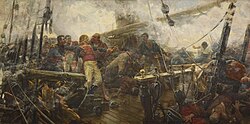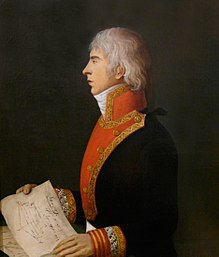Spanish shipSan Juan Nepomuceno
 ReplicaSan Juan Nepomuceno
| |
| History | |
|---|---|
| Name | San Juan Nepomuceno |
| Namesake | John of Nepomuk |
| Ordered | 20 September 1763 |
| Builder | Juan Donesteve |
| Laid down | 19 June 1765 |
| Launched | 18 October 1766Guarnizo(Cantabria) |
| Captured | 22 October 1805 byRoyal Navy |
| Name | HMSBerwick |
| Acquired | Captured 22 October 1805 |
| Renamed | HMSSan Juan |
| Fate | Paid off & sold 8 January 1816 |
| General characteristics | |
| Type | Third-rateship of the line |
| Tons burthen | 1,740 tonsbm |
| Length | 181 ft (55 m) |
| Beam | 47 ft 4 in (14.43 m) |
| Height | 146 ft (45 m) |
| Depth of hold | 21 ft 3 in (6.48 m) |
| Sail plan | Full-rigged ship |
| Complement | 640 |
| Armament |
|
San Juan Nepomucenowas a Spanishship of the linelaunchedin 1765 from the royal shipyard inGuarnizo(Cantabria). Like many 18th century Spanish warships she was named after a saint (John of Nepomuk). She was a solidly built ship of proven seaworthy qualities. Captured by the BritishRoyal Navyduring theBattle of Trafalgar,the ship was renamed firstHMSBerwick,thenHMSSan Juan.The ship was discarded in 1816.
Design and description
[edit]Hersister shipswereSan Pascual,San Francisco de Asis,San Lorenzo,Santo DomingoandSan Agustín.
She was originally fitted with a total of 74 cannons: 28 24-pounders, 30 18-pounders, 8 12-pounders and 8 8-pounders, and was manned by 8 officers, 11 midshipmen, 19 leading seamen and 492 able seamen (530 total). Her supply capacity was for 60 days victuals and 80 days water.
Service history
[edit]In 1793, she took part in the Anglo-Spanish occupation ofToulonunder the command of AdmiralDon Juan de Lángara.Four years later, in 1797, she was part of a Spanish fleet underTeniente GeneralJosé de Córdoba y Ramosthat fought against the British at theBattle of Cape St. Vincent.
Battle of Trafalgar
[edit]
The Battle of Trafalgar is the historical feat in which she participated and of which we have the best account. In spite of being dismasted byAdmiral Nelson'sartillery on 21 October 1805, she achieved glory in this battle under the command of the commanderDon Cosme Damian Churrucaand constituted for the Spaniards a handsome example of the heroism of their nation and the bravery of their sailors.[citation needed]
San Juan Nepomucenowas one of the last ships still fighting after most of the French ships had surrendered and most of the Spanish ships had either been captured or had yielded. The commander, Don Cosme Churruca, had previously ordered for the flag to benailed to the highest mast.[citation needed]At the time, it was commonplace for ships to signal surrender bylowering their nation's flag.'Nailing the flag' was a way to tell the enemy, allies, and indeed the ship's own crew and officers not to expect an easy surrender. As the hours passed Churruca, whose leg had been torn off by a cannonball,[citation needed]the deck of his ship covered by the blood of his wounded and dead seamen, continued to stubbornly order his ship's batteries to fire. Mortally wounded, the Basque-born Churruca prohibited his officers from surrendering and ordered them to continue returning fire whilst he remained breathing. His officers kept their word, even after Churruca died and command of the ship had been passed to thesecond-in-command,Francisco de Moyna,[citation needed]who continued the fight until he himself was killed. He was replaced by the next officer in command who also refused to surrender. However, unable to break the circle of fire formed by the six enemy ships, includingDefiance,TonnantandDreadnought,and in order to prevent the ship from sinking with all the wounded trapped below, the last officer left alive inSan Juan Nepomucenoyielded with over 400 dead and injured on board.[citation needed]

Royal Navy service
[edit]After Trafalgar, the ship was taken into British service and briefly renamed HMSBerwickbefore adopting the name HMSSan Juan.In honour of Churruca's courage, the cabin he had occupied while alive bore his name on a brass plate, and all who entered it were required to remove their hats as a mark of respect for a gallant enemy.[citation needed]She initially served as a basehulkatGibraltarfrom 1805 to 1808 before being recommissioned in September 1808 as aprison shipunderCommanderJohn Gourly.[citation needed]
During thePeninsular WarSan Juanwas fitted to act asflagshipto a flotilla ofgunboatsbased in Gibraltar. For this task she was re-rated as asloopand placed under the command of Commander Thomas Vivion, who was the first flotilla commander, taking post in 1810. He was followed subsequently by Commander James Tillard who took command in 1812. There were a total of fourteen lieutenants under his command, each of whom took charge of one of the gunboats in the flotilla. As the gunboats had little capacity for accommodation, the lieutenants were assigned to, and lived aboardSan Juan.[citation needed]
In later serviceSan Juanacted as flagship to the admirals appointed as Commander-in-Chief Gibraltar. In 1813 she was flagship to Rear AdmiralSamuel Hood LinzeewithCaptainJohn Fraser acting asflag captain.In 1814 she was flagship to Rear AdmiralCharles Elphinstone Fleemingwith Captain Gardiner Henry Guion acting as flag captain. Her final commission began in October 1814 when she reverted to her original role as a base hulk under the command of Lieutenant Charles M'Kenzie.San Juanwas finally paid off and sold atGibraltaron 8 January 1816.[citation needed]
Bibliography
[edit]- John D. Harbron,Trafalgar and the Spanish Navy(1988)ISBN0-87021-695-3
- Robert Gardiner,Frigates of the Napoleonic Wars(2000)ISBN978-1-86176-292-4
- Rif Winfield,British Warships in the Age of Sail 1793-1817(2005)ISBN978-1-84415-717-4
- Winfield, Rif; Tredrea, John M; García-Torralba Pérez, Enrique & Blasco Felip, Manuel (2023).Spanish Warships in the Age of Sail 1700—1860: Design, Construction, Careers and Fates.Barnsley, UK: Seaforth Publishing.ISBN978-1-5267-9078-1.
External links
[edit]- Historia del navío de línea San Juan Nepomuceno(in Spanish)
